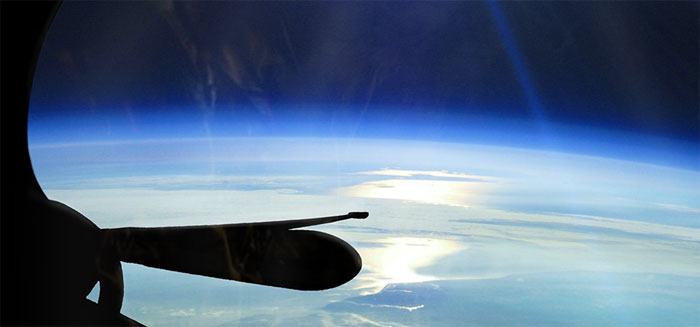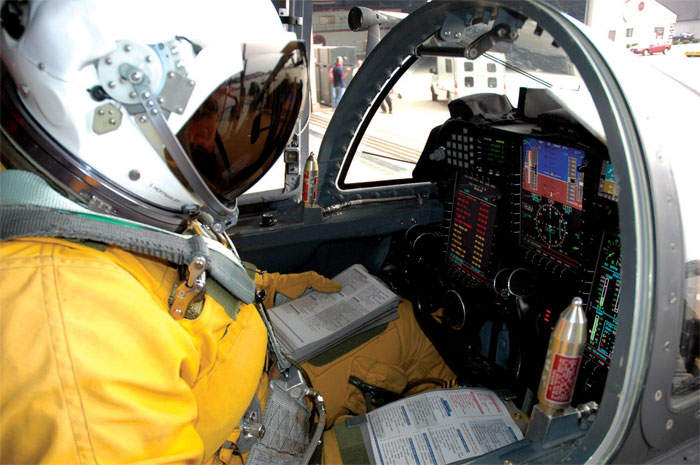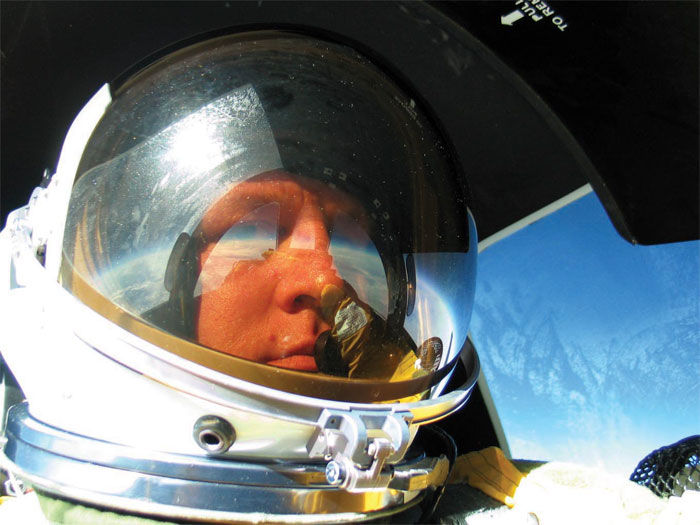.

Alone, Unarmed and Unafraid
-
Clarence “Kelly” Johnson, famed Lockheed Skunk Works® founder, said he would have a U-2 in the air in just eight months. Incredibly, Johnson almost met his own impossible deadline, delivering the first U-2 for a test flight on July 29, 1955, nine months after signing the contract.
Today, we celebrate the 60th anniversary of the first U-2 test flight by speaking with U-2 pilots.
U-2 pilots fly many types of missions, from intelligence collection to surveying dirt patterns for signs of makeshift mines and IEDs to wildfire support and other natural disaster assistance. One advantage to the U-2 over unmanned aircraft is having a pilot in the loop, able to react quickly to threats, mid-flight mission changes or timely search and rescue coordination.
Unlike other pilots, U-2 pilots fly solo, without armament, for 10-12 hours. What gives them confidence is the U-2’s highly capable defensive suite and the knowledge that the aircraft is incredibly reliable.
Why U-2 Pilots Fly
Similar to the Dragon Keepers behind The High Flying Heart of the U-2 Dragon Lady, U-2 pilots feel a tremendous dedication and responsibility to ensuring combat leaders’ decisions are well-informed and keeping troops on the ground as safe as possible.
“Supporting the troops is why pilots want to get airborne every day,” said Greg Nelson, retired U.S. Air Force U-2 pilot and current Lockheed Martin U-2 test pilot. “It’s about saving lives. Troops on the ground may not know it, but we’ve got their backs. We’re watching out for them, and saving even one life makes the mission worth it.”
“Without a wingman or another person in the plane, time in the U-2 can be lonely; completing the mission makes it satisfying and fulfilling,” said Stu Broce, retired U.S. Air Force U-2 pilot and current ER-2 pilot, NASA. “You know you did most of that on your own, and supporting the troops was my motivation when I served. I owed it to them to be my best in the cockpit at all times.”
“The boots on the ground are my heroes,” said Rob Rowe, retired U.S. Air Force U-2 pilot and current Lockheed Martin U-2 test pilot. “Intel is as necessary to our troops as boots or fatigues. That’s why we fly, to provide the best intel possible.”
Call Signs and Memorable Moments
Call signs become a pilot’s first name. Let’s be clear: you don’t ask for a call sign and you definitely don’t request a specific one. They’re assigned by squadron-mates, and may be chosen based on a play on words, a pun, a dubious accomplishment or a myriad of other reasons.
Greg Nelson received his call sign based on the television show Coach and its lead star, Craig T. Nelson. “Coach” Nelson was well known for coaching new U-2 pilots. Fun fact, Craig T. Nelson played a U-2 pilot in Call to Glory.
“I remember that on one particular weapon inspections mission, we got the request to fly overhead to ensure that when inspectors went through the front door, weapons weren’t simultaneously going out the back door,” said Coach. “In hindsight, it sounds funny and seems like something out of a cartoon, but at the time, it was a serious mission that I was proud to support.”
Stu Broce was initially referred to as “Beef,” but a sister squadron pilot had already claimed the call sign. So Beef became “Meat” Stu. Get it? Meat stew.
“Once, I was on a mission on Christmas, and during a lull, I turned off all of the lights in the cockpit just to get familiar with what it would look like without a generator,” said Meat. “It was really wild being in complete darkness in the middle of nowhere, literally.”
Rob Rowe was initially called “Rut” Rowe, a la Scooby Doo’s “uh-oh,” but that quickly changed the day that Rob crash-landed in front of his peers, skidding to a stop with a fire under the fuselage. From that day forward, he became known as “Skid” Rowe.
“We occasionally see fireballs - very large, very bright meteors - while flying, but on this particular night, I looked up to see a fireball directly overhead,” said Skid. “It instantaneously went from pitch black to very bright. The fireball left a contrail and you could see parts of it flying off. It was definitely the biggest fireball I’ve ever seen.”
Quelle: Lockheed Martin
-





Fotos: USAF
Flying High with the NASA ER-2
NASA’s two ER-2s were built as U-2R models in the 1980s with a unique configuration designed for testing. These two aircraft never flew for the Air Force but have played an important role in Earth science research because of their ability to fly into the lower stratosphere at subsonic speeds, enabling direct stratosphere sampling as well as virtual satellite simulation missions. The aircraft’s unique configuration enables studies such as stratospheric ozone concentrations over Antarctica and the Arctic. Learn more.
Fun Fact: NASA’s ER-2 set a world-altitude record for the class of aircraft with a takeoff weight between 26,455 and 35,275 pounds Nov. 19, 1998, when the aircraft reached 68,700 feet.
Quelle: Lockheed Martin
-

NASA operates two Lockheed ER-2 Earth resources aircraft as flying laboratories in the Airborne Science Program under the Agency's Science Mission Directorate. The aircraft, based at NASA Armstrong's Building 703 in Palmdale, CA, collect information about Earth resources, celestial observations, atmospheric chemistry and dynamics, and oceanic processes. The aircraft also are used for electronic sensor research and development, satellite calibration, and satellite data validation.
Program History
NASA acquired its first ER-2 aircraft in 1981 and a second in 1989. They replaced two Lockheed U-2 aircraft, which NASA had used to collect science data since 1971. The U-2s, and later the ER-2s, were based at NASA's Ames Research Center in Moffett Field, CA, until 1997, when the ER-2s and their operations moved to NASA Dryden.
Since the Airborne Science Program's inaugural flight on Aug. 31, 1971, NASA U-2s and ER-2s have flown more than 4,500 data missions and test flights in support of scientific research.
NASA's ER-2 set a world-altitude record for the class of aircraft with a takeoff weight between 26,455 and 35,275 lb on Nov. 19, 1998, when the aircraft reached 68,700 feet.
NASA ER-2s have played an important role in Earth science research because of their ability to fly into the lower stratosphere at subsonic speeds, enabling direct stratospheric sampling as well as virtual satellite simulation missions. The aircraft's unique capabilities enable studies such as stratospheric ozone concentrations over Antarctica and the Arctic.
In August and September 1987, an ER-2 traveled to Chile to conduct overflights of the Antarctic. The direct measurements from the ER-2, combined with remote-sensing measurements from ground-based and satellite sensors, provided information suggesting that human-made chemical compounds, specifically chlorofluorocarbons, caused ozone depletion over the Antarctic region. The first field study of summer polar ozone conditions took place during a series of flights from Fairbanks, Alaska, between April and September 1997.
During the winter of 1999/2000, an ER-2, teamed with NASA's DC-8 flying science platform, participated in the SAGE III Ozone Loss and Validation Experiment (SOLVE). Based in Kiruna, Sweden, SOLVE was the largest field campaign conducted to measure ozone in the Arctic stratosphere.
The ER-2 has been an invaluable tool for studying tropical cyclone (hurricane) development, tracking, intensification and landfall impacts. During the July 2005 Tropical Cloud Systems and Processes mission based in Costa Rica, the ER-2 carried instruments that measured the buildup and behavior of tropical storm systems over Mexico and Central America and in the eastern Pacific, Caribbean, and Gulf of Mexico. The aircraft flew over several hurricanes, including Emily and Dennis that were both violent Category 4-5 storms, and collected information on their entire vertical structure. Data were collected about the temperature, humidity, precipitation, and wind related to tropical cyclones and other related phenomena that often lead to development of more powerful storms at sea.
Satellite Sensor Development and Simulation
Since Airborne Science's inception, the NASA U-2s and ER-2s have assisted in developing satellite sensors by testing prototypes or by simulating proposed configurations with existing systems.
The ER-2 carries the Airborne Visible Infrared Imaging Spectrometer (AVIRIS), a 224-band hyper-spectral scanner designed by NASA's Jet Propulsion Laboratory in Pasadena, CA. AVIRIS is a prototype of hyper-spectral scanners proposed for orbit on future satellite platforms. Collecting data with prototype instruments allows scientists to analyze and interpret the information future satellites will provide.
In December 2010, the ER-2 first carried the Multiple Altimeter Beam Experimental Lidar (MABEL), an Ice, Cloud and land Elevation Satellite-2 (ICESat-2) simulator. MABEL, developed by NASA's Goddard Space Flight Center in Greenbelt, MD, was flown to test the satellite's measurement concept. MABEL was again mounted in the nose of the aircraft in March 2011 for flights over a variety of terrains. In April 2012, the aircraft carried MABEL for a deployment to study Greenland's ice sheet, glaciers and sea ice. Based in Iceland, the ER-2 flew to altitudes of 65,000 feet as the sensor gathered algorithm development data that may allow ICESat-2, scheduled to launch in 2016, to make more precise measurements of global ice.
ER-2 Deployments
The ER-2 has deployed to six continents investigating global warming and ozone depletion and acquired extensive digital multi-spectral imagery for global climate change research and aerial photography. These missions have tested prototype satellite imaging sensors and have acquired Earth resources data for research projects sponsored by NASA and federal agencies such as the U.S. Forest Service, Environmental Protection Agency, U.S. Fish and Wildlife Service, and the Army Corps of Engineers.
ER-2 Aircraft Capabilities
The ER-2 is a versatile aircraft well suited to perform multiple mission tasks. The ER-2 operates at altitudes from 20,000 feet to 70,000 feet, which is above 99 percent of the Earth's atmosphere. Depending on aircraft weight, the ER-2 reaches an initial cruise altitude of 65,000 feet within 20 minutes. Typical cruise speed is 410 knots. The range for a normal eight-hour mission is 3,000 nautical miles yielding seven hours of data collection at altitude. The aircraft is capable of longer missions in excess of 10 hours and ranges in excess of 6,000 nautical miles. The ER-2 can carry a maximum payload of 2,600 lb (1,179 kilograms) distributed in the equipment bay, nose area, and wing pods.
The aircraft has four large pressurized experiment compartments and a high capacity AC/DC electrical system, permitting it to carry a variety of payloads on a single mission. The modular design of the aircraft permits rapid installation or removal of payloads to meet changing mission requirements.
Quelle: NASA
4376 Views
